Imagine, as an educational leader, that you could create your own school from the ground up. Reimagine space to create places of learning, accepting, and understanding. Form environments that are driven by stakeholder needs and wants. In 2009, one person had a vision for a new, state-of-the-art comprehensive K–12 nontraditional school. The vision became embraced by many and was adopted in 2014 by Prince William County Public Schools (PWCS). In 2016, groundbreaking occurred and, with the first shovel planted, set a course in motion that would change the direction of service provision for the most in-need and vulnerable students in the division.
In 2018, the doors of Independence Nontraditional School opened to serve students of all ages, academic and social-emotional needs, and ability levels. No student was excluded; all were welcome. Independence went on to have record-breaking graduation numbers and offered opportunities to students never afforded in the 35th largest school division in the United States. Our NASSP Virtual Tour will explore how our school was conceived and the ways in which its unique design helps serve the needs of all of its students.
Reimagining Places and Spaces
Reimagining places and spaces to address the cultural, social-emotional, intellectual, and technological needs of students and staff is integral to effective instruction and stakeholder ownership. Sensory rooms, flexible spaces, and state-of-the-art technology are purposefully used to promote equitable access and accommodations for all stakeholders. Creating spaces with outcomes in mind is leveraged to include planning and processes to bring them to fruition. Forecasting needs and transferability of spaces create the opportunity for educational breadth; in essence, the ability to expand and contract was achieved to meet the needs of the whole school.
The story of Independence involved taking three existing unique schools and combining them to create a larger, interactive community that serves the entire school division. Incorporating the strengths of each school, fashioning locations that honored each, and creating new spaces that enhanced the shared vision of “Developing Integrity, Intellect, and Ingenuity in All Students” was achieved through the inclusion of school-based personnel and students in the physical planning, construction execution, and finishing of the school. Our 143-member staff serve a highly diverse student population (90 percent ethnic diversity) that is high need (70 percent free and reduced-price meals), has specific language or learning requirements (28 percent English-language learners and 33 percent special education students), and graduate at a 96 percent rate.
Individualized Instruction, in Person and Virtual
The reimagining of space parlayed into the ability to offer individualized instruction and counseling for a rolling enrollment of approximately 750–1,000 students each year and providing 1:1 technology for both the student’s home and classroom use. Moreover, the construct of the school affords for multiple instructional shifts to be run to meet the academic, social-emotional, home, world-of-work, and/or community needs of the learner. In essence, students can attend one, two, or three sessions. Meals are provided free of charge to all students for each session, as is county transportation. A student can graduate at Independence in two and a half years with an advanced studies diploma attending one session. A 4×4 modified block schedule, five computer labs, and laptop carts in every classroom create access for both students and staff.

Educational space is just not concrete, it is virtual. Thus, the digital world was incorporated in our space creation to maximize learning and student needs. Moreover, this space was supported within the concrete confines of the brick and mortar school by developing mirrored technology access, concurrent programs, and common instructional delivery. Creating concurrent space using a standards-based format, professional educators engage in multiple strategies to include project-based learning, portfolio assessment, mastery-based learning, inquiry-based learning, and experiential learning. The digital world becomes concrete in the building while site-based activities become virtual for students accessing online.
During our NASSP Virtual Tour, you will learn how one person’s vision became that of an entire school division, and how empowering others to make that vision their own will showcase how reimagining places and spaces can be transferable to you, your school, or your division. Your voice as a school-based educational leader can reshape the educational landscape of your school and division. You will hear how this process evolved and the results achieved; most importantly, you will garner the excitement of what was accomplished and what is on the horizon for Independence Nontraditional School and for you as an educational leader in your community.
This blog is part of NASSP’s Virtual Tour Series. Be sure to visit NASSP’s Facebook page on March 17 at 1:00 p.m. (ET) to participate in the live tour and join Bob at 9:00 p.m. (ET) on March 21 for a Pau Hana, an informal virtual networking session to ask questions and keep the conversation going.

